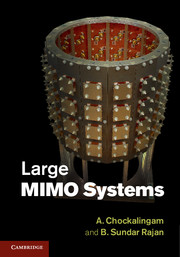Book contents
- Frontmatter
- Dedication
- Contents
- Preface
- Acknowledgments
- Abbreviations
- Notation
- 1 Introduction
- 2 Large MIMO systems
- 3 MIMO encoding
- 4 MIMO detection
- 5 Detection based on local search
- 6 Detection based on probabilistic data association (PDA)
- 7 Detection/decoding based on message passing on graphical models
- 8 Detection based on MCMC techniques
- 9 Channel estimation in large MIMO systems
- 10 Precoding in large MIMO systems
- 11 MIMO channel models
- 12 Large MIMO testbeds
- Author index
- Subject index
- References
3 - MIMO encoding
Published online by Cambridge University Press: 18 December 2013
- Frontmatter
- Dedication
- Contents
- Preface
- Acknowledgments
- Abbreviations
- Notation
- 1 Introduction
- 2 Large MIMO systems
- 3 MIMO encoding
- 4 MIMO detection
- 5 Detection based on local search
- 6 Detection based on probabilistic data association (PDA)
- 7 Detection/decoding based on message passing on graphical models
- 8 Detection based on MCMC techniques
- 9 Channel estimation in large MIMO systems
- 10 Precoding in large MIMO systems
- 11 MIMO channel models
- 12 Large MIMO testbeds
- Author index
- Subject index
- References
Summary
The job of MIMO encoding is to map the input symbols, say, from a modulation alphabet, to symbols to be transmitted over multiple transmit antennas. Spatial multiplexing and space-time coding are two well-known MIMO encoding techniques [1],[2]. Spatial modulation (SM) is a more recently proposed scheme for multiantenna communications [3]. These MIMO encoding schemes do not require any knowledge of the CSI at the transmitter, and hence are essentially “open-loop” schemes. MIMO encoding using CSI at the transmitter is referred to as MIMO precoding, which is treated in Chapter 10. Spatial multiplexing is an attractive architecture for achieving high rates. Space-time coding is attractive for achieving increased reliability through transmit diversity. SM serves a different purpose. It allows fewer transmit RF chains than the number of transmit antennas to be used without compromising much on the rate. This reduces the RF hardware complexity, size, and cost. In spatial multiplexing and spacetime coding, information is carried on the modulation symbols. In SM, on the other hand, in addition to modulation symbols, the indices of the antennas on which transmission takes place also convey information. This is why SM does not compromise much on the rate. Among the three MIMO encoding schemes, spatial multiplexing is the simplest, and its complexity rests more at the receiver in detecting the transmitted symbol vector. SM, though simple conceptually, needs additional memory to construct the encoding table at the transmitter for selecting the antennas for transmission.
- Type
- Chapter
- Information
- Large MIMO Systems , pp. 25 - 39Publisher: Cambridge University PressPrint publication year: 2014



